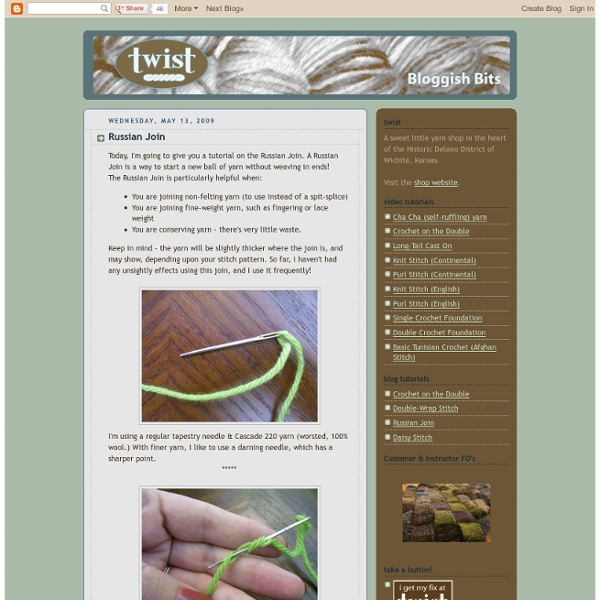Twist: Russian Join

Tutorial :: Making Brushed Amigurumi - The Former Roxycraft Blog
For amigurumi, I usually don't use natural fibers, acrylic has so many benefits for making dolls like durability, washability, and shape resiliance that using natural fibers seemed like a waste of time and effort. But I recently came into a stash of Brown Sheep Lamb's Pride Bulky. It's an awesome yarn with a wool/mohair blend and I couldn't let it just sit on the shelf. I had seen around the web some dolls that were brushed and thought I might give it a shot. Since I hadn't seen a tutorial for amigurumi specifically, my first attempt ended in me killing some doll eyes by scratching them silly...so I thought I might run you through the process so you can avoid some of the pitfalls. Materials:Any spun Natural fiber yarn (except cotton)A dog slicker brush (mine has a soft brush on the flip side which I found came in handy at the end) Close-up of what the bristles of the slicker brush look like: (click any picture for a larger version) Here is what became of that head!
Tutorial: How to read a crochet chart worked in the round
Tutorial how to read a Crochet Chart/Diagram Crochet motifs are often charted and this requires that you know the basics about reading crochet diagrams. In this tutorial I show you how to read a chart with the help of the crocheted motif above. A crochet diagram shows you the pattern by using crochet symbols. Each symbol refers to a specific crochet stitch. These symbols are used in many countries and the symbols represent the same stitches whatever they are used in Japan, Germany or Scandinavia. On top of the page you see a crocheted swatch worked in the round. Below is a crochet diagram for that same swatch and below that a stitch guide for the different symbols that are included in the stitch diagram. Now I will take you by the hand and give you an instruction how you read the above crochet chart/diagram. You start reading the chart from the center. In the center in black you see the foundation chain. Row 1 The first row shown in blue is worked counter clockwise. Like this:
Crochet School Lesson 21: Reading Crochet Charts
Remember in the last lesson where I said that the simpler the pattern the better? Well how's this for simple? (hover your mouse over to see the difference between the square and the chart overlay) Do you see how you could possibly not even need words to make a pattern if you knew what the symbols were? Note: we have talked about US vs UK terms so far. I've found that some patterns will give written out directions along with a chart, which makes it a bit easier if you aren't sure what a symbol means. This first chart is of the general stitches that we have learned. The arrows on this image point to the parts of the stitch that make up the symbol. I for one love to read charts because I'm a visual person and the more information I can get packed into a visual is better. Here are the symbols for the other stitches and variations we have learned throughout crochet school: Now that you know the symbols, you probably should know how to read them. Figure 1: Figure 2: Figure 3: Figure 4 :
Tunisian Crochet How-To... Basic Tunisian Crochet Stitch
Welcome friends! This is my first How-To blog post and I am excited to share with you. I am going to show you how to Tunisian Crochet. Some of you may have heard of it and others maybe not. Either way, you will learn how to do it today! Tunisian Crochet is a fabulous way of mixing crocheting and knitting. To start off, you need a Tunisian Crochet hook. As you can see, it’s a long crochet hook… … with a stopper at the end like a knitting needle. If you can’t get your hands on one of these, you can use one of your regular crochet hooks. As far as yarn, feel free to use whatever you have on hand that will work with your hook. Stitches Ch– Chain Yo– Yarn over Sts- Stitches Sk– Skip Sl St– Slip Stitch Did you notice there’s no single, double, treble (etc.) crochets? A big thing you need to know and keep in mind as you do this is that you will go back and forth on your work and never turn. The Forward Pass you will be working right to left and The Return Pass you will work left to right. Chain 15
Annemarie's Haakblog
Free, Online Crochet Pattern Link Dire
Related:
Related:



